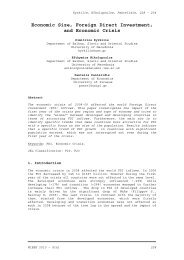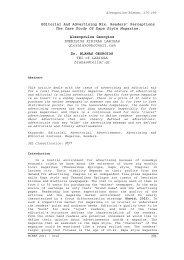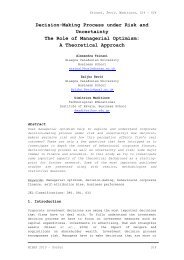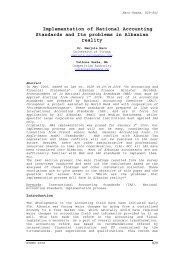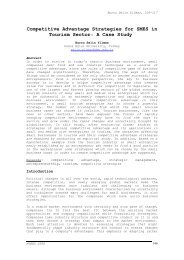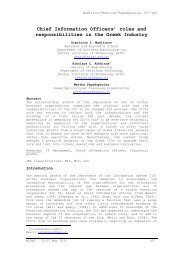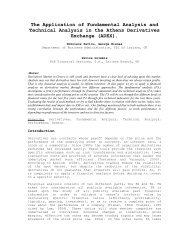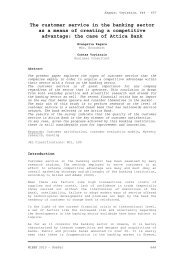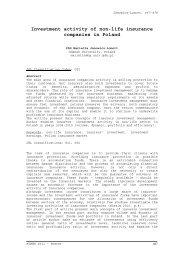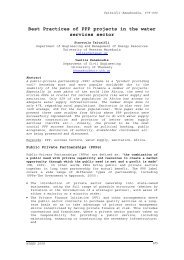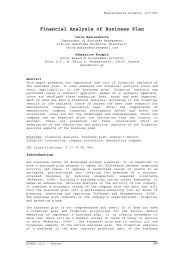Du Pont Analysis of a Bank Merger and Acquisition between ... - mibes
Du Pont Analysis of a Bank Merger and Acquisition between ... - mibes
Du Pont Analysis of a Bank Merger and Acquisition between ... - mibes
Create successful ePaper yourself
Turn your PDF publications into a flip-book with our unique Google optimized e-Paper software.
Kyriazopoulos-Hadjimanolis, 157-176<br />
• In some instances <strong>of</strong> mergers there will be required , new logos, new<br />
writing material, new forms or publications, <strong>and</strong> th us new stocks for<br />
expendable supplies <strong>and</strong> equipment items that alread y exist at an<br />
additional cost.<br />
• The uncertainty with regards to the approval <strong>of</strong> the merger by the<br />
proper authorities.<br />
• The possibility that the bank that will be created after the merger<br />
will have surplus personnel in some departments or positions. For<br />
example, it is possible to take place a necessary d oubling <strong>of</strong><br />
specialists in matters <strong>of</strong> foreign exchange markets, in matters <strong>of</strong><br />
personnel training etc.<br />
• A possible overoptimistic projection for the size o f pr<strong>of</strong>itability<br />
that will result from the combination <strong>of</strong> operations <strong>of</strong> the merged<br />
banks will have as a result the buying bank to pay an exorbitant<br />
price for the bank being bought out.<br />
• In many cases, the returns <strong>of</strong> the share <strong>of</strong> the bank s that made<br />
buyouts <strong>of</strong> other banks were lower than the return o f the sector as a<br />
whole.<br />
• High social cost because it is usually observed a r eduction in<br />
employment resulting from lying <strong>of</strong> personnel.<br />
In a merger <strong>and</strong> acquisition situation Markowitz (19 52) considers two<br />
rules while starting a new portfolio optimization m odel for the<br />
investor. First the investor does (or should) maxim ize expected<br />
returns, <strong>and</strong> secondly the investor does (or should) consider expected<br />
return a desirable thing <strong>and</strong> variance <strong>of</strong> return an undesirable thing.<br />
Even though a merger <strong>and</strong> acquisition might be consi dered a relatively<br />
good move in the competitive market, facts prove th at many times it can<br />
have a bad impact in the staff employed by the orga nizations. As an<br />
example, I bring the case <strong>of</strong> merger <strong>and</strong> acquisition in Hellenic bank<br />
market, which in the period <strong>of</strong> 1998 – 2003 had 3,62 7 jobs canceled<br />
after the dem<strong>and</strong> <strong>of</strong> the shareholders to have dem<strong>and</strong> limitations in the<br />
number <strong>of</strong> employed staff (Mylonakis, 2006).<br />
With the introduction <strong>of</strong> one single market for fina<br />
later on after the introduction <strong>of</strong> euro, an unprece<br />
financial consolidation has taken place in the Euro<br />
the late 1990’s the number <strong>of</strong> mergers <strong>and</strong> acquisiti<br />
with the introduction <strong>of</strong> Monetary Union. According<br />
academics the process <strong>of</strong> banking integration seems<br />
<strong>and</strong> is expected to continue in the following years.<br />
forces underpinning this consolidation process, suc<br />
rapid technological advances <strong>and</strong> financial globaliz<br />
to exist.<br />
ncial services, <strong>and</strong><br />
dented process <strong>of</strong><br />
pean Union. <strong>Du</strong>ring<br />
ons had increased<br />
to bankers <strong>and</strong><br />
far from completed<br />
First many <strong>of</strong> the<br />
h us the effect <strong>of</strong><br />
ation will continue<br />
Although banking assets as a percentage <strong>of</strong> GDP grew from 177.2% in 1985<br />
to 244.2% in 1997 (European Central <strong>Bank</strong> 1999) the number <strong>of</strong> European<br />
banks decreased from 12,670 in 1985 to 8,395 in 199 9 (European Central<br />
<strong>Bank</strong> 2000). This development is mostly driven by me rgers <strong>and</strong><br />
acquisitions among European banks. As a consequence , the European (EU-<br />
15) market concentration measured by the market sha re <strong>of</strong> the top 5<br />
banks in terms <strong>of</strong> total assets (CR5) grew by 12 per centage points over<br />
the last 10 years to 57.1% in 1999. Second, the num ber <strong>of</strong> financial<br />
institutions per 1,000 inhabitants in the European Union is doubled<br />
than that in the United States <strong>of</strong> America, suggesti ng that there is<br />
room for consolidation in the European Union. Third , there is a<br />
considerable degree <strong>of</strong> heterogeneity across Europea n Union countries in<br />
terms <strong>of</strong> concentration <strong>of</strong> banks.<br />
The impact <strong>of</strong> bank consolidation on the transmissio<br />
is a multidimensional issue. According to most empi<br />
n <strong>of</strong> monetary policy<br />
rical studies, an<br />
MIBES 2011 – Oral 160



